VOL.53, NO. 3
Great Agony of Body and Spirit: The Labor of Adaptation in Film Versions of The Red Shoes
Elizabeth Klett
Michael Powell and Emeric Pressburger’s The Red Shoes (1948) is widely considered the greatest dance film ever made and a classic of British cinema. Ian Christie calls it a “masterpiece” (36), Adrienne McLean notes that it “has become legendary” (135), and Mark Nicholls describes it as “vastly influential” (33). Further evidence of the film’s lasting impact is its recent transformation into a stage ballet by British choreographer Sir Matthew Bourne. His production, which premiered in 2016, removes the film’s dialogue to tell the story entirely through movement. The stage production was filmed live at Sadler’s Wells Theatre in London in 2019, and released as a film in 2020. I will examine the ways in which Powell and Pressbuger’s film adapts Hans Christian Andersen’s 19th century fairy tale, and how their film in turn has been adapted by Bourne. The fairy tale focuses on the suffering of a young girl, Karen, whose obsession with a pair of red shoes forces her to dance relentlessly until she repents her sins. In contrast, the 1948 and 2020 film versions of the story center on an adult woman, the ballerina Victoria Page, whose desire to dance places her into a triangular relationship with two demanding men: her husband, the composer Julian Craster, and her employer, the impresario Boris Lermontov. I argue that Powell and Pressbuger’s adaptation of Andersen’s tale deliberately reframes the narrative of dancing as inherently connected to work, and particularly the grueling labor of the ballet dancer. Through scenes focused on rehearsals and performances, they reveal the literal pain and sweat that goes into making beautiful art, particularly the embedded ballet (also titled “The Red Shoes”) at the film’s center. Bourne’s stage adaptation further develops this theme by downplaying Victoria’s upper-class status, revealing the toll that her career trajectory takes on her body and mind, and presenting us with a “Red Shoes” performance that (unlike in the 1948 film) unfolds onstage in real time.
Andersen’s tale, originally published in 1845, contains significant differences from the later adaptations. Its main character is a “little girl,” initially so poor that she has to wear “big wooden clogs that chafed against her ankles until they turned red” (309). Karen wears two pairs of red shoes: the first, made of scraps by “Old Mother Shoemaker,” are worn to her mother’s funeral, while the second, made by “a prosperous shoemaker” out of “shiny” leather, are worn to her confirmation (310). The shoes initially represent everything Karen does not have: comfort, protection, and beauty. As the story continues, they come to signify Karen’s upward mobility, out of desperate poverty into gentility, since she is adopted by a wealthy old lady. However, they also signify her vanity and materialism. Once she dresses in “proper new clothing,” she begins to focus on her mirror, which tells her she is “beautiful” (310). Further, when she is in church, Karen can “think only about her red shoes,” suggesting that she fetishizes the shoes at the expense of religion. As Maria Tatar notes, in Andersen’s tales, “beauty has transformative energy, but its link with vanity arouses profound fears about excesses both evil and dangerous” (280). The story suggests that Karen deliberately profanes the church by wearing the beautiful shoes to services, and that she therefore deserves the punishment that ensues; “her sin consists of a pride so strong that it leads her to disrespect God” (Backstein 42). An old soldier curses the shoes to stick to Karen’s feet so that when she begins to dance, she cannot stop. Later, a “stern” angel makes it clear that she will dance until she dies: “Dance in your red shoes until you turn pale and cold, and your skin shrivels up like a mummy” (Andersen 312). Karen evades this fate only through a different horrific punishment: she persuades an executioner to chop off her feet. Once she repents, she is filled with “peace and joy,” and is taken up to heaven at the conclusion of the story (314). Susanne Mørup Hansen writes that this is “one of … Andersen’s most cruel and most religious tales,” and emphasizes the harshness of Karen’s punishment that compels her repentance (171).
The popularity and influence of Andersen’s fairy tales cannot be overstated; as Jack Zipes notes, Andersen “had become one of the most popular writers in Europe and America during the nineteenth and early twentieth centuries” (194). The “rags to riches” theme of “The Red Shoes” is typical of many of his stories; yet, as Zipes argues, upwardly mobile characters usually have to “learn … a set of manners, customs, normative behavior, and thinking that enables them … to rise in social status” (194-195). Further, Andersen’s narrative is inevitably gendered; like many of his young heroines, Karen is part of “a cult of grotesque suffering,” in which children (especially girls) endure pain to learn a moral lesson (Tatar 280). Karen fails to learn the Christian virtues of humility and obedience, instead embracing vanity and materialism. During her confirmation, the red shoes were “all Karen could think about, even when the pastor placed his hand on her head and spoke of … the fact that she should now be a good Christian” (311). When her guardian insists that she wear black shoes to church, Karen puts on the red shoes instead, and thinks about them while taking communion: “She forgot to sing the hymn, and she also forgot to recite the Lord’s Prayer” (311). The executioner knows that she is “evil,” and it is only after he chops off her feet that she can “repen[t] her sins with all her heart” (313). This narrative trajectory is typical of Andersen’s stories focused on lower-class child protagonists, which show that “she must be humbled if not humiliated” to enforce Christian values such as obedience (Zipes 95). “The Red Shoes” takes the humbling process to an extreme, however, in its emphasis on Karen’s protracted physical suffering.
Victoria, the heroine of Powell and Pressbuger’s film, likewise endures physical pain in her quest to become a great dancer. Further, the ballet embedded in the middle of the 1948 film, in which Vicky dances the lead role, parallels her story and foreshadows her eventual death. This ballet-within-the-film reveals Powell and Pressbuger’s adaptation of Andersen’s story. Indeed, Andersen’s significance to the film is signaled from the opening credits, in which the title is presented over an image of a book with Andersen’s name written on the side, suggesting that his work serves as the foundation of the cinematic adaptation (see Figure 1). Lermontov describes the ballet’s narrative as taken “from a fairy tale by Hans Andersen.” Lermontov’s narration simplifies the story, omitting the main character’s name and impoverished history:
It is the story of a girl who is devoured by an ambition to attend a dance in a pair of red shoes. She gets the shoes, goes to the dance, and at first all is well, and she is very happy. At the end of the evening, she gets tired and wants to go home. But the red shoes are not tired. In fact, the red shoes are never tired. They dance her out into the streets. They dance her over the mountains and valleys, through fields and forests, through night and day. Time rushes by, love rushes by, life rushes by. But the red shoes dance on … In the end she dies.
Lermontov’s dramatic rendition (delivered in mesmerizing fashion by actor Anton Walbrook) disconnects the red shoes from vanity, materialism, and the girl’s disregard for Christian piety that are central to Andersen’s story. Instead, his choice of words, focusing on the girl’s “ambition to attend a dance,” aligns her much more closely with Vicky, who is likewise “devoured” by her ambition to become an elite ballerina. When the “Red Shoes” ballet is staged, however, some of the references to Andersen have returned. Most prominently, the ballet begins with a Shoemaker (choreographed and performed by Leonide Massine) who creates a pair of blood-red pointe shoes and places them in his shop window to tempt the girl. She desires them as soon as she sees them, particularly when the Shoemaker provides a vision of her dancing in them. Once she has succumbed and put them on, she dances almost continuously for the remainder of the ballet. Andersen’s Christian context manifests at the conclusion of the work, when the exhausted girl dances up to the steps of a church to seek help. The priest appears, “using one of the most powerful T poses in cinema with his arms outstretched representing the cross of Christ to cleanse the girl of her sins” (Starzynski 235). Black-clad churchgoers point at her accusingly (as seen in Figure 2), and then turn their backs, leaving her in the clutches of the demonic Shoemaker, who forces her to continue dancing. The priest eventually pities her, removing the shoes, and she dies in his arms. This moment anticipates the ending of the film, in which Vicky, right before she is due to go onstage to perform “The Red Shoes,” torn between the competing demands of Julian and Lermontov, leaps off a balcony into the path of an oncoming train.1 As she lies dying in Julian’s arms, she asks him to “take off the red shoes.”
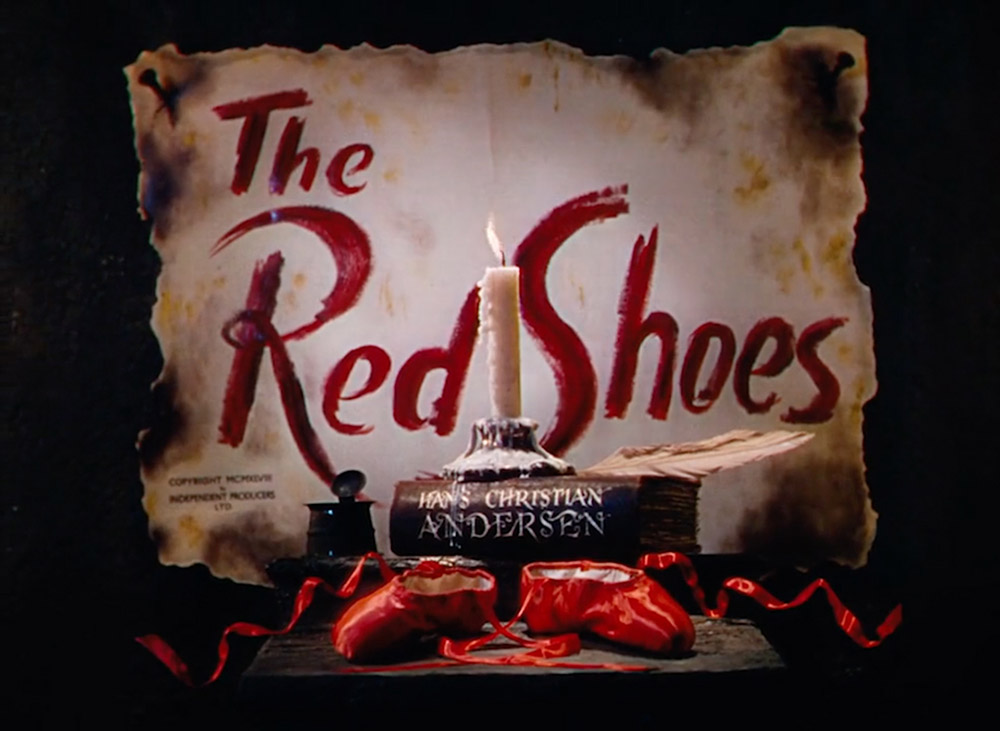
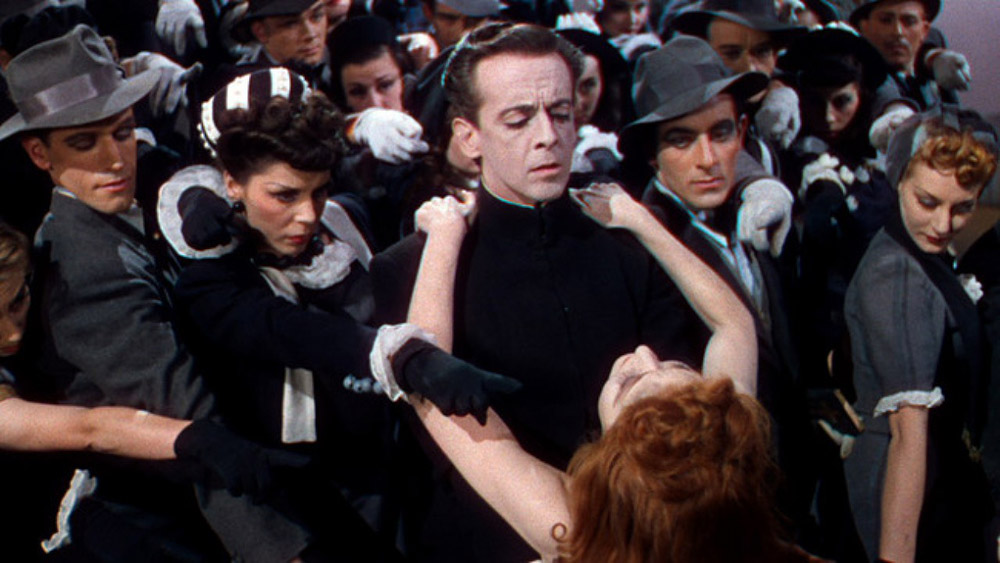
While there are certainly connective threads between Andersen’s story and the film – most prominently the motif of the red shoes dancing the girl to death – there are also a significant number of differences. Perhaps the most important difference is that Vicky, unlike Karen, desperately wants to dance. She understands and accepts the physical demands that ballet makes on her. In an exchange with Lermontov after a particularly difficult rehearsal, he tells her that “a great impression of simplicity can only be achieved through great agony of body and spirit.” That is to say: To attain perfection, the ballerina must suffer, while masking the labors performed by her body to create a beautiful aesthetic image. Unlike Karen, a young girl who suffers as a punishment for her vanity and materialism, Vicky is a deeply ambitious woman who views dancing not as a choice, but as a necessity. This is shown in the first conversation that Vicky has with Lermontov:
LERMONTOV: Why do you want to dance?
VICKY: Why do you want to live?
LERMONTOV: I don’t know exactly why, but I must.
VICKY: That’s my answer too.
While many critics have seen Vicky as a pawn or puppet who is manipulated by powerful men, I read her as an active, desiring subject who dances because she wants to, rather than because she is a victim of outside forces. In scholarship on Powell and Pressbuger’s film, it is not difficult to find critics who read Vicky in stereotypically feminine and limiting ways. Charles Affron argues that she “is a simple projection of male desire whether she is Lermontov’s prima ballerina or Julian’s wife” (54). Susan Kavaler-Adler's psychoanalytic analysis finds that Vicky “is compelled to submit” to Lermontov and “does not surrender freely,” but rather becomes the “heroine/victim” of her own story (155-156). There is certainly evidence within the film to support these contentions. For example, the final scene has Vicky literally caught between the two feuding men; she sits weeping with slumped shoulders, while they stand on either side of her, yelling at each other and berating her. This scene directly contributes to her tragic death, suggesting the degree to which her fate is ultimately dictated by the conflicting pressures that they exert upon her. Kiley Kapuscinski defines the “Red Shoes syndrome” as one that “positions womanhood and artistry as antithetical subject positions,” which can eventually “lead women to self-destruction” (902-903). However, such readings focus inordinately on the film’s ending, and tend to ignore the ways in which Powell and Pressburger stage Vicky’s point of view. The film expresses her passionate desire to dance, in ways that move beyond seeing her onscreen performances as eclipsed by her eventual death, or as enacting “her submission to male desire” (Affron 54).
Two key scenes of Vicky performing onstage illustrate these aspects of her character. First, early in the film, soon after Vicky joins Lermontov’s company, she dances the lead role of Odette, the white swan, in Swan Lake at a small London theatre. This ballet (like “The Red Shoes,” derived from the fairy tale tradition) tells the story of a princess who is turned into a swan by a magician. The spell can be broken only by a man who swears true love for her. The ballet ends in tragedy; although a prince vows to rescue Odette, the magician tricks him into breaking his vow. As Andrew Moor notes, Swan Lake is part of “the canon of romantic ballets,” which communicate “powerful ideological messages, often of martyred heroines and female sacrifice” (210). However, the scene of Vicky dancing as Odette does not play into these reductive images of women. Rather, Powell and Pressburger choose to show Vicky dancing a solo from Act 2 of the ballet that incorporates a quick tempo, virtuosic turns, and lightning-fast footwork, instead of a portion of the ballet that emphasizes Odette’s fragility and dependence on a male partner.2 Her solo concludes with a series of piqué turns, in which she spins from one side of the stage to another. Cinematographer Jack Cardiff skillfully conveys Vicky’s point of view as she dances, revolving the camera to convey what she sees as she performs the complex series of turns. The film then cuts to a close-up of Vicky’s smiling face as she dances, showing her commitment to the performance and the ecstatic state she is in while performing. The camera stops spinning only when Vicky does, prioritizing her point of view. Lermontov witnesses her transcendent dancing, convincing him to give her the lead in his new ballet “The Red Shoes,” suggesting that her emotional and physical commitment to her art is the driving force behind his decision to cast her.
The second scene occurs after Vicky’s successful debut in “The Red Shoes," and comprises a montage of her subsequent performances in three ballets: Coppélia, La Boutique Fantasque, and Les Sylphides. The sequence is inaugurated by a conversation between Vicky and Lermontov, in which he alludes to their earlier discussion, asking her what she wants: “To live?” She responds immediately: “To dance.” Her dancing in each of the ballet extracts included in the montage conveys an ecstatic commitment similar to the previous Swan Lake scene. It also demonstrates her range, since the Coppélia scene is humorous, the Boutique Fantasque can-can dancing is sexy, and the Les Sylphides extract is slow and romantic. A number of critics have noted that some of the roles Vicky performs in this sequence suggest her essential passivity and Lermontov’s control over her. Moor, for example, asserts that “her identity has been choreographed out of existence altogether, like the automaton we see her dancing in Coppélia” (209). However, such readings fail to note that the represented ballets are in fact more subversive in their narratives – or evade the concept of narrative altogether. In Coppélia, Vicky plays the role of Swanilda, a young woman who mischievously impersonates a doll to rescue her fiancé. As Iris Julia Bührle notes, this was an “unusual situation” for a 19th century story ballet, and Swanilda is portrayed as a “courageous” character who “outwits [the dollmaker] Coppelius by slipping into the automaton’s (pointe) shoes” (182). In the brief scene, Vicky as Swanilda responds to the “magical” commands of Coppelius to step forward, raise her shoulders, and blink her eyes (see Figure 3). She also moves of her own accord; when he turns his back to rummage in his magical supplies, she bends to watch him, hands on her hips, and then deliberately steps back into position in a different place, provoking confusion in the doddering Coppelius. The scene effectively communicates that Swanilda, not Coppelius, has the upper hand. In La Boutique Fantasque Vicky plays a doll that comes to life and dances an exuberant can-can (as we see in the performed extract from the ballet). Here again she plays a character who gains control in a potentially disempowering situation: later in the story, the animated dolls run away from the dollmaker to pursue their own lives. Les Sylphides, by contrast, is a plotless ballet, focusing on the synergy of Chopin’s music, Massine’s choreography, and the long white dresses drawn from the Romantic ballet tradition. The value of non-narrative dance “derives exclusively from technique and its aesthetic qualities (grace, beauty, dynamism, interplay with the music, etc.)” (de Lucas 104). Vicky plays the leading female role in the short scene from this ballet, but is not playing a character; therefore, the sequence does not reinforce the idea of her as passive and dominated by men.
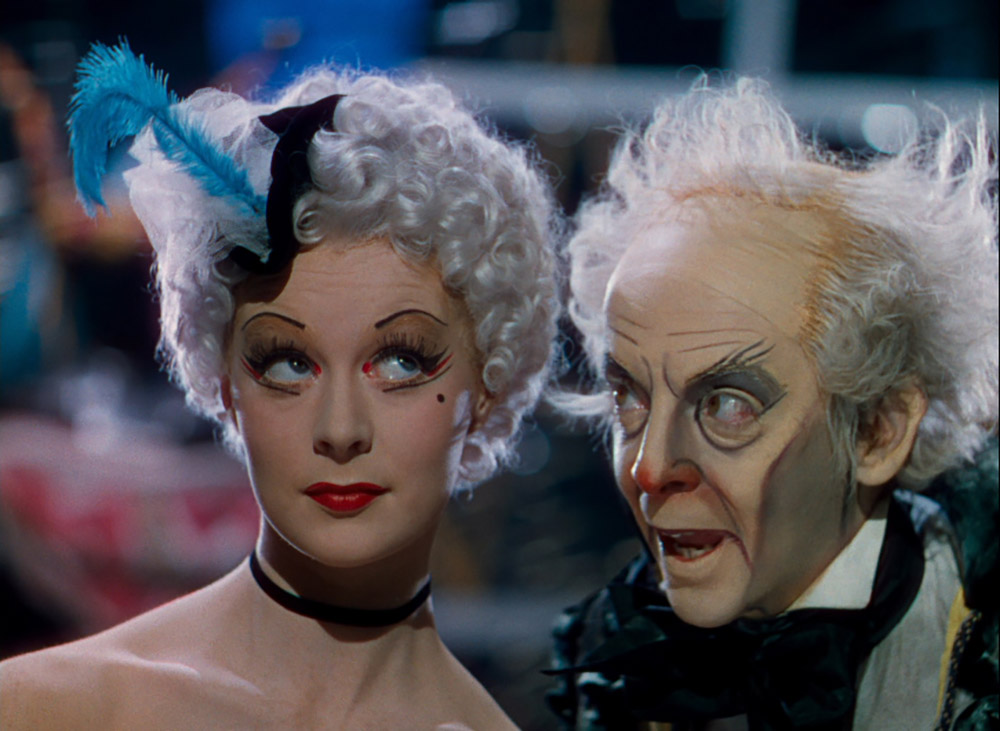
While The Red Shoes devotes considerable screen time to showing us Vicky and her fellow dancers performing onstage, it also foregrounds the work that occurs offstage to create the impression of “great simplicity” demanded by Lermontov. As McLean notes, the film shows us “a whole world in which magic is commonplace and desirable but created with material things – wood, paint, fabric, sweat, muscular effort” (151). In particular, Vicky’s “agony of body and spirit” is shown through the grueling rehearsal process for “The Red Shoes” ballet. We see her trying hard to perform the choreography devised by Grisha Liubov, while her partner Ivan complains that “she’s putting too much into it,” meaning that Vicky is dancing “full out” rather than marking the steps for rehearsal purposes. Vicky gets into an argument with Julian, who has composed the ballet’s score, about the timing of a particular step; the music, she contends, is “too fast.” Grisha sides with Julian, berating Vicky loudly and criticizing her performance. By the end of the scene, Vicky is sweating, disheveled, and dispirited. Although the opening night performance of “The Red Shoes” primarily dispenses with this backstage perspective in favor of rendering the ballet through film techniques, Powell and Pressburger also pause the performance twice to show the film audience the physical toll it takes on Vicky. First, she freezes mid-dance to confront the demonic Shoemaker, and there is a close-up of her face with beads of sweat visible on her forehead (see Figure 4). Second, toward the end of the performance, she leaps offstage, grabs a towel from an attendant, and wipes the sweat off her face. The attendant assists her with a lightning-fast costume change into a dirty and torn version of her dress before Vicky whirls back onto the stage. Finally, the morning after the successful premiere, Vicky is the first one back in the studio warming up for company class, indicating both her work ethic and the fact that she has avoided, as Grisha puts it, any “swelling” in her “head.” While ballet might look like “the poetry of motion,” as Vicky’s aunt romantically puts it, the film reveals that it is achieved through hard and repetitive work that takes a toll on both the body and the spirit. Powell and Pressburger therefore deliberately revise Andersen’s tale on a number of levels, primarily by reframing the female protagonist’s relationship to dancing.
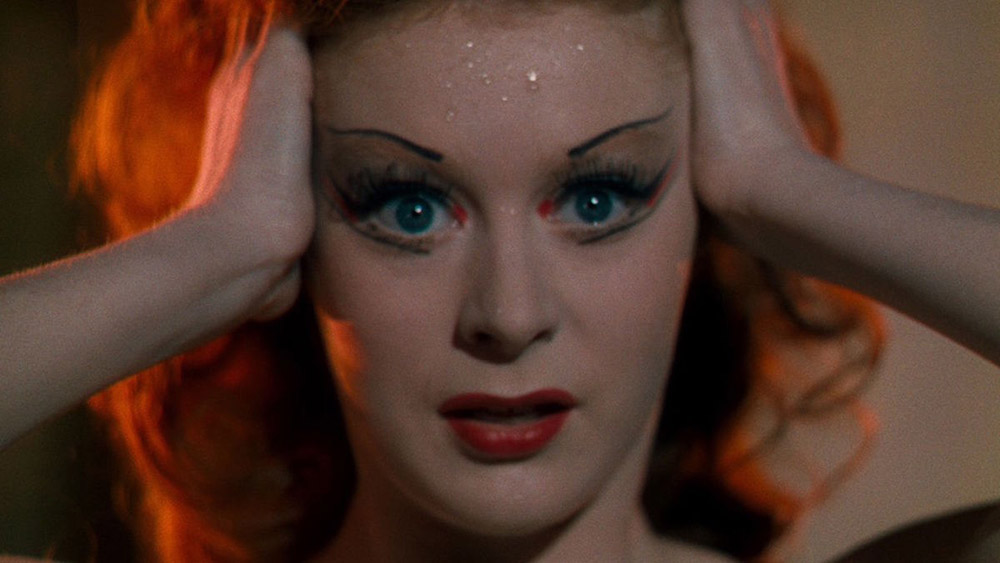
Matthew Bourne’s 2016 stage production signals its relationship with both of its antecedents, saying that it is based on Powell and Pressbuger’s film and Andersen’s fairy tale. Unlike both, however, there are no words in Bourne’s version, only choreography, as is typical of his “brand of dance-theatre that tells stories imaginatively and accessibly” through “multi-dimensional” means (Jacobs 54). Further, although he pays homage to Andersen, his primary referent is clearly the 1948 film, since he sticks closely to the film’s plot surrounding the triangular relationship between Vicky, Julian, and Lermontov. He includes the film’s supporting characters as well, particularly the choreographer Grisha and the leading dancers Ivan and Irina. Bourne’s debt to Powell and Pressburger extends in part to the costume design, which includes direct references to some of the film’s looks, such as Lermontov’s red velvet robe, Ivan’s carefully draped rehearsal wear, and Vicky’s silky pajamas. He also includes “The Red Shoes” as an embedded ballet performance which closes the first act. A significant change, however, is that Bourne does not use the Oscar-winning score composed by Brian Easdale; instead, he uses a compilation of film music composed by Bernard Herrmann-- a decision that is partly practical, since Easdale’s score does not provide enough music for an evening-length work. Bourne also noted in a 2017 interview that he is a “big admirer of [Herrmann’s] work,” and compiled the score to pay tribute to him as a “Golden Age Hollywood composer.” He chose music from Herrmann’s considerable oeuvre– including his scores for Citizen Kane (1941) and The Ghost and Mrs. Muir (1947)– to create “a whole new beautifully melodious dramatic score that’s never been heard before” (“Matthew Bourne on The Red Shoes”).
Bourne further develops Powell and Pressburger’s focus on the theme of dance as labor through the stage design, the changes he makes to Vicky’s character, and the embedded ballet. Lez Brotherston’s ingenious set incorporates a mobile proscenium arch that can swivel back and forth to serve as both a backdrop for when the characters are performing, but also show when they are backstage. Initially these distinctions feel mostly clear, as in the opening sequence showing the Lermontov company dancing in an unnamed ballet. When it begins, the “onstage” side of the proscenium (seen in Figure 5), with its red velvet curtains and elaborate gold trim, faces the theatre audience, providing a backdrop for Irina, Ivan, Grisha, and the corps de ballet to perform a story that involves a love triangle, with two men competing for the attention of the prima ballerina. (This story clearly foreshadows Vicky’s entanglement with Julian and Lermontov.) During this performance, the proscenium reverses, showing the viewer the backstage area behind the curtain, while we are still able to see the dancers who are “onstage,” watched by an audience that we can glimpse beyond the footlights. Irina’s body sags the moment she is offstage, she fans herself languidly, and Lermontov encourages both her and Ivan before they go onstage again.
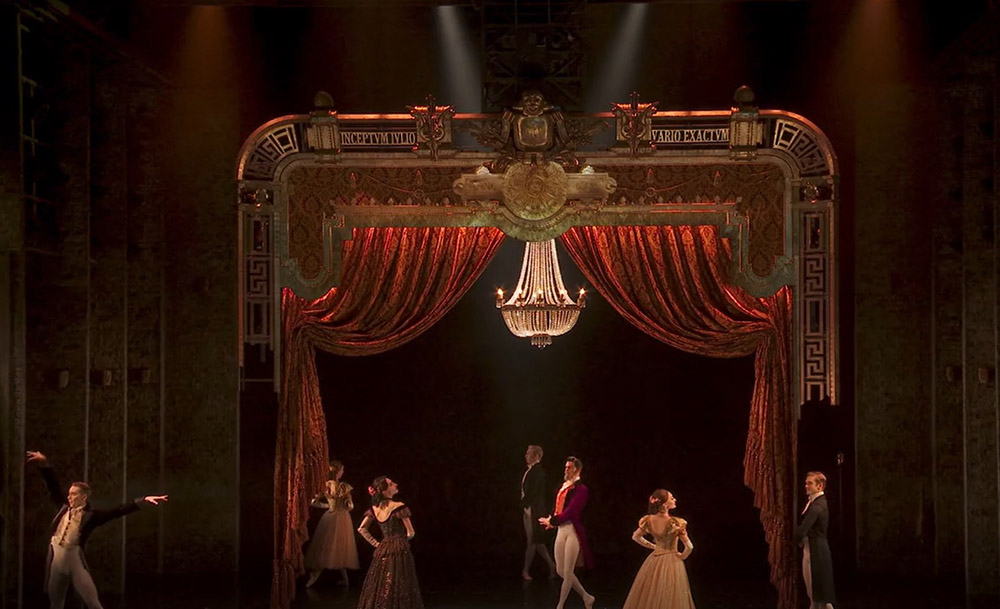
As in Powell and Pressburger’s film, Bourne shows the dancers’ labor that goes into creating the beautiful onstage performance. He uses this technique throughout his production, and as it continues, the lines between onstage and offstage become blurred and uncertain. In Act 2, for instance, the audience sees what appears to be an onstage performance of a new ballet. Partway through the performance, Lermontov enters and the dancers stop, indicating that it is actually a dress rehearsal. The scene turns into a struggle between Lermontov and Julian, who has written the music, and precipitates Julian and Vicky leaving the company. The confusion between onstage and offstage becomes even more pronounced once they have moved back to London and Vicky begins dancing in a vaudeville production. There is an extended scene (with the proscenium in the “backstage” setting) of the vaudevillians rehearsing. Vicky, clad in a short costume with suggestive tassels, rehearses the dance she is to do with two strongmen (see Figure 6), watched by the other performers, who are either completely bored or lustfully coveting Vicky’s exposed body. The audience begins to see what Vicky sees, as she starts to hallucinate. She glimpses Lermontov beyond the footlights. Julian laughs wildly at her dancing. The other cast members– a ventriloquist with a dummy, tap dancing men dressed in Egyptian costumes– grab at and grope her, and she pushes them away with disgust. Bourne shows how the line has become blurred between offstage and onstage, real and illusion, for Vicky, and for the audience as well.
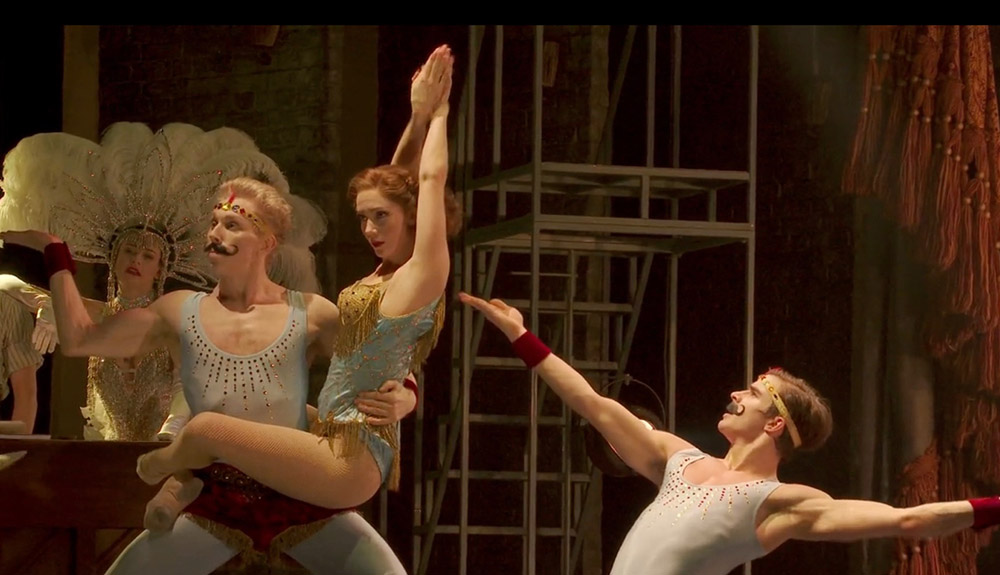
By encouraging us to see these scenes from Vicky’s perspective, Bourne presents some revisions to her character from the 1948 film. Powell and Pressburger’s Vicky is clearly from a wealthy background; the first time we see her, she is seated in a box at the ballet with her aunt, Lady Neston, wearing an evening gown and diamonds. Lady Neston attempts to use her influence to get Vicky an audition with Lermontov at a sumptuous party she hosts in his honor, and while she fails, it does bring Vicky to Lermontov’s notice. This audition scene is revised in Bourne’s production; he does not strongly suggest a familial relationship between Vicky and Lady Neston, and Vicky appears in the scene to dance as party entertainment for the aristocratic guests, with accompaniment by Julian. This lack of a wealthy background eventually explains why Vicky is forced to try dancing in vaudeville after leaving Lermontov’s company (a choice that does not appear in Powell and Pressburger’s film), contributing to her mental breakdown. Further compounding her isolation and desperation is her deteriorating relationship with Julian, who, unlike in the 1948 film, does not have an opera commissioned by Covent Garden, but like her is forced to work in obscurity.
Bourne choreographs a complex bedroom pas de deux for Vicky and Julian late in Act 2 that corresponds to a scene from Powell and Pressbuger’s film, but with significant changes to emphasize their failing marriage. In the earlier film, Vicky and Julian are lying in the bedroom of their London home in the middle of the night. Julian gets up to work on his opera at the piano in the next room, and Vicky stealthily opens a dresser drawer filled with pointe shoes to look at and touch them. As Julian’s music becomes louder, she goes into the other room to embrace him tenderly as he works. Although each is clearly drawn to their own artistic obsessions in this scene, the emphasis is on the “mysterious force [that] seems to be holding them together,” as Mark Connelly notes (53). The design of their home is fantastical and romantic rather than realistic: their bedroom “looks more like a suite in a grand hotel,” and Julian plays in an “equally huge salon” (Connelly 53). Bourne’s version presents an altogether different vision of a humble bedroom with shabby furnishings. When Vicky approaches Julian as he works and embraces him, he flings off her hands and stalks away from her. She goes after him but Julian tries to pull away from her and reaches out his arms toward his piano, yearning to go back to his work. Vicky gets out a suitcase that contains the red shoes and puts them on, looking at them longingly (see Figure 7). Julian crawls toward her menacingly on all fours, and as she rises onto pointe, he grabs her feet to make her stop dancing, but she pulls away from him. Their partnering is sometimes tender, incorporating sustained balances where they cling to each other, but also turns violent, with Julian trying to assert his dominance by repeatedly immobilizing her. In the end, he forces her to put away the red shoes, and takes the suitcase away while she cries. Unlike Powell and Pressburger’s Julian, Bourne’s Julian forbids Vicky to dance ballet at all, leading directly to her crumbling mental state and the nightmarish scene of her death. This choice also reverses the narrative dynamic of Andersen’s story, in which the controlling male figures force the girl to dance.
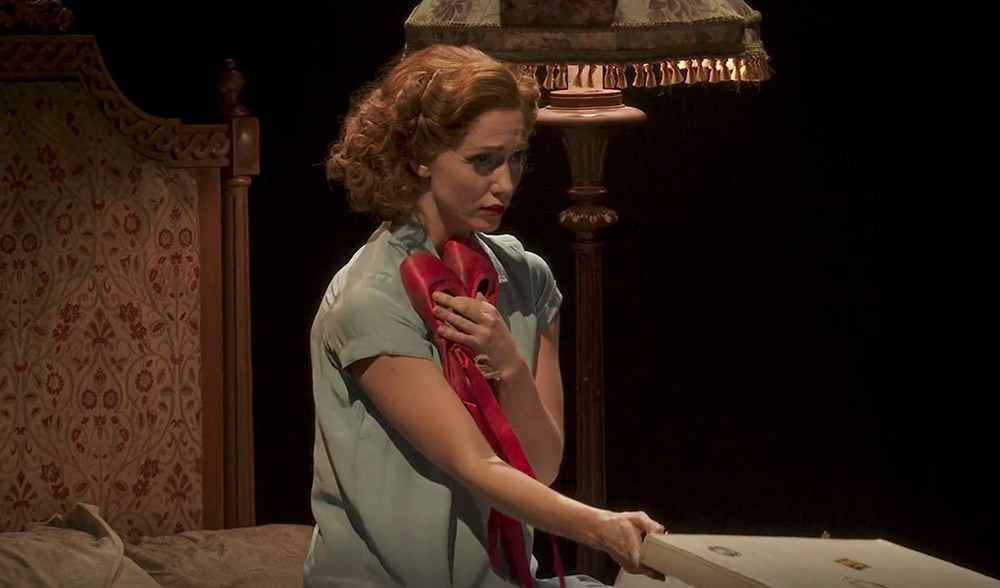
A further significant difference between the 1948 and 2020 films is that Bourne’s version must rely completely on the labor of his dancers to perform the story in real time. In the embedded ballet “The Red Shoes,” Ashley Shaw as Vicky and the other dancers in Bourne’s New Adventures company really give a virtuoso performance. Powell and Pressbuger’s film, by contrast, blends the theatrical and the cinematographic. Initially their approach is “realistic,” providing the viewer with a sense of being in the audience for the opening night. They show a disembodied pair of hands paging through the oversized program for “The Red Shoes.” After the overture, the curtain parts to reveal Grisha in the role of the Shoemaker, dancing in front of a painted backdrop representing his shop. After a few bars of music, however, Powell and Pressburger use a lap dissolve to fade out the Shoemaker and his shop and fade in the more expansive scene of the company dancing in the town square. As Connelly notes, “The ‘live’ ballet the Monte Carlo audience is watching becomes far more one-dimensional than the rich, complex affair the cinema-goer gains … as the ballet breaks free from the confines of the stage and creates its own realities” (55). As “The Red Shoes” ballet within the film continues, the use of film techniques provides a sense of magic that cannot be achieved on the stage. For example, Vicky as the Girl jumps into the red shoes and they swiftly attach themselves to her feet, satin laces tying up almost instantly to enable her to start dancing. This cinematic magic takes the viewer “into the mind and imagination of the dancer as she performs in the ballet,” so that we often see what Vicky sees (McDonald 114). During the middle of the performance, in her confrontation with the Shoemaker, as he stands before her with his arms raised menacingly over his head, the images of first Julian, and then Lermontov in the same pose are superimposed over him. Later, in a more tender moment, we see Julian leave his conductor’s platform in the orchestra pit and magically cross onto the stage toward Vicky, momentarily partnering her before fading into the image of her actual partner, Ivan. Finally, as Vicky nears the end of the performance and is becoming exhausted, the camera is placed behind her, revealing that the applauding theatre audience has been replaced with a wild and storm-tossed ocean. These cinematic and fantastical images continually remind the viewer that they are watching a film, not a live performance, since Powell and Pressburger are taking “the audience on a journey far beyond the confines of the theatre itself” (Connelly 54).
By contrast, Bourne’s live version of the “Red Shoes” ballet must be performed within those theatrical confines, and this condition inevitably shapes his vision of how it unfolds, which primarily rewrites the story as incorporating sexual temptation and corruption. As in the 1948 film, the first image we see of the embedded ballet is a red velvet curtain that parts to begin the performance. Much of what follows is different, however; the opening scene has Vicky and Ivan playing the Girl and Boy wearing simple gray costumes, dancing together in a country setting. Vicky’s dress is high-necked, plain, and modest, her hair is straight and pulled back from her face, and her feet are bare. Their surroundings are likewise gray and cloudy, and their partnering is sweet and romantic. A set piece representing an elegant black lamppost is lowered in (the strings that hold it in place are visible), and the music shifts to a more rapid tempo as the corps de ballet enters, everyone dressed in black, suggesting city dwellers. The men wear suits and bowler hats, and the women are in dresses that incorporate lace and high slits up their thighs. The Girl and Boy look around wonderingly, and it does not take long before she is tempted by the entrance of Grisha as the Pimp, dangling the red shoes in front of her. Her desire for the shoes allows her to fall under the influence of the Pimp, and the scene shifts to a nightclub/brothel with a blood-red backdrop. The Girl re-enters wearing the red shoes and a matching red dress with a plunging neckline. She willingly dances with the male patrons, one of whom hands over cash to the Pimp in exchange for her. The Boy, still in his gray clothes, enters and is shocked by the Girl’s dancing with other men, but the Pimp keeps him away from her. Time passes and the Girl’s dress becomes tattered and worn. The Boy returns as a priest at the end (as in the 1948 film), and is able to remove the red shoes before the Girl dies in his arms.
Bourne’s version of the embedded ballet uses almost no scenery apart from a few set pieces that fly in and out. The stage is defined and confined by the backdrop and a series of four archways that frame the space. The dancers and the choreography are primarily what create the story and action, rather than the design, constituting a significant departure from the Powell and Pressburger film, which uses art director Hein Heckroth’s painted backdrops and scenic designs to shape the trajectory of the embedded ballet. However, Bourne also uses film projections to create settings and imagery, a device that gives a distinctive look to the embedded ballet, since he does not use it anywhere else in the production. The countryside setting at the beginning is indicated through projected gray silhouettes of mountains, with rustic homes and the spires of a church that scroll by on the backdrop, and then retreat into the background for the transition to the city. As the lamppost lowers in, the countryside silhouettes flip out of sight and are replaced by the spires of city buildings, likewise gray. The ominous clouds overhead grow darker as the Pimp dangles the red shoes in from the wings, a splash of tempting color against the monochromatic backdrop. The shoes seem to color the entire backdrop for the brothel scene, with subtle flames suggesting a hellish quality. Once the Girl realizes that the shoes will not stop dancing, Bourne uses a series of projections to suggest the passage of time: first, a whirling clock face, then the pages of a calendar blown by the wind, and finally a bare wind-swept tree against a grim unchanging backdrop. The final projection re-focuses on the church from the opening scene, with gravestones and black birds flying across the looming sky. When the priest removes the red shoes in the ballet’s final moments, stars shoot from the ground into the sky, framing the couple at center stage (see Figure 8). Bourne’s use of filmic devices within the embedded ballet offers a nod to Powell and Pressbuger’s blending of cinematic and theatrical techniques, but deliberately does not duplicate any imagery from the 1948 film. Rather, his use of film projections suggests the ways in which “live forms have become mediatized,” as Philip Auslander observes (5).
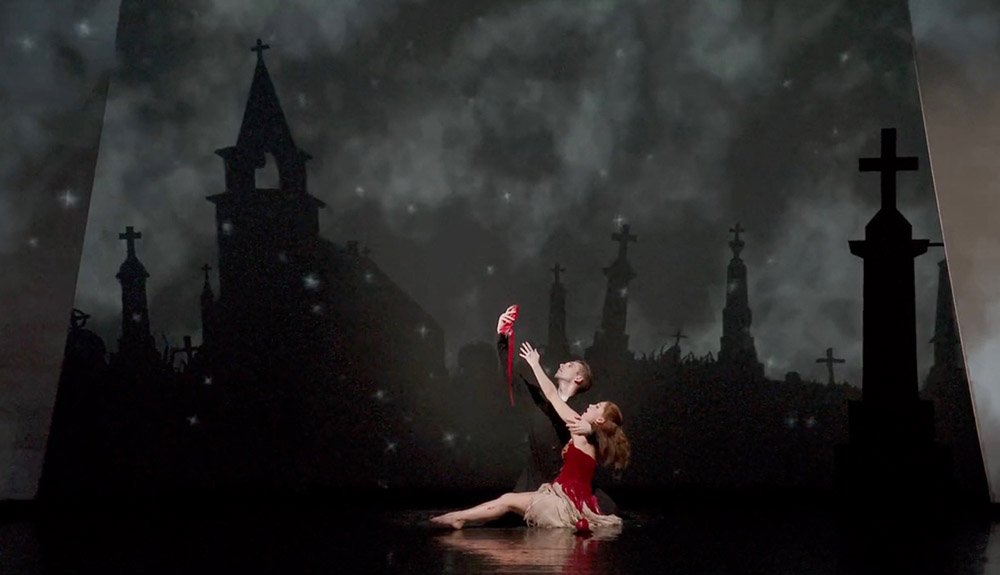
The interplay between live theatrical performance and film that Bourne stages within the embedded ballet connects to larger questions about the nature of the 2020 film, which was initially made to be broadcast to cinemas, and then released simultaneously on DVD, Blu-ray, and downloadable streaming video. Michael D. Friedman’s questions about the nature of such artifacts seem relevant here: “[Is] it a play, a movie, a televised event, or some hybrid of all three?” (457). He uses the term “cinemacast” to denote a film version of a live theatrical event that is shown in cinemas, arguing that they “constitute a postmodern pastiche of … theater, cinema, and television” (458). Steve Benton uses the term “streamcast” for a film version of a live event that can be downloaded and streamed “to living room flat screens, laptops, or even cellphones,” and unlike with a cinemacast, gives “individual audience members control of the play, pause, fast forward and rewind buttons” (“All About Eve: Screens on Stages on Screen”). It is important to note that Bourne and New Adventures have built cinemacasting and streamcasting of their theatrical productions into their work since 2017, when they filmed The Car Man. Bourne notes that, “Cinema plays a vital role in ensuring we can take our productions to many more places, both across the UK and around the world, than it is possible for us to reach with our live performances,” suggesting that accessing audiences remotely is a significant goal for their company (“News: The Red Shoes in Cinemas”). Although this might make the 2020 film seem entirely different from the 1948 film, in practice the distinction seems to collapse, particularly because in researching and writing this essay, I streamed both films to my laptop and made copious use of the play, pause, and rewind buttons. As Auslander notes, “film is no longer an unrepeated experience confined to particular places and times,” as it was when Powell and Pressbuger’s film was released in 1948. Instead, “whereas film was once experienced as representation, it is now experienced as repetition” (18).
Since The Red Shoes was “staged to be documented at least as much as to be seen by an audience” (Auslander 14), the 2020 film version is marked by the contributions of the screen director, Ross MacGibbon, as much as Bourne, who directed the production for the stage. MacGibbon used six cameras to capture the live performance from various angles, and to convey an experience that no audience member could see while watching from a theatre seat at Sadler’s Wells in London. Indeed, as Charlotte Kasner notes, a spectator watching the 2020 film as a cinemacast or streamcast is “in the curious position of watching a film containing a ballet based on a film containing a ballet” (“Sir Matthew Bourne’s The Red Shoes on the big screen”). The film’s use of cinematography and editing is relatively simple. The three most common shot types used are: an extreme long shot, in which the entire stage is visible and the camera is static; a long shot revealing a portion of the stage but ensuring that the dancers’ entire bodies and movements are visible using a mobile camera; and a medium shot, in which the dancers’ bodies are filmed from the waist up to enable details of facial expressions to come across clearly. Bourne and MacGibbon use straight cuts between these three types of shots for the most part, and the lack of close-ups suggests that the priority is on transparency: on ensuring that the cinema audience can see the choreography and dancing, and that the film conveys a “faithful” capture of the live performance. Yet, as Alison Stone argues, “the emphasis on transparency obscures the extent of the creative intervention the [film] makes in the stage production” (627). In other ways it is clear that Bourne and MacGibbon are trying to present the film as a film, rather than as a theatrical performance. For example, although the live show was performed with an intermission, they cut any reference to it in the 2020 film. Further, in the opening moments of the embedded ballet, when the velvet curtains part and reveal the countryside setting, the film editing makes Vicky and Ivan appear onstage as if by magic. Like all filmic captures of live theatrical productions, the 2020 film is “an intrinsically hybrid art form” (Aebischer and Greenhalgh 6), combining elements of cinema and stage into a cross-genre construct.
Nonetheless, when we watch “The Red Shoes” embedded ballet in Bourne’s film, we are aware that we are watching the dancers convey the story relying on their own bodily skill and on the masterful choreography. Indeed, the only times that Shaw is not onstage during this twenty-minute-long ballet is when she is offstage performing two quick costume changes: from the gray dress to the red dress, and from the latter into the final tattered version of the garment. Lacking the cinematographic magic that attaches the red shoes to Moira Shearer’s feet in the 1948 film, Shaw must put on the red shoes herself. Without using the kind of cinematic techniques employed by Powell and Pressburger, this film foregrounds the labor of the dancing bodies onstage, simultaneously conveying its proximity to and distance from Andersen’s fairy tale. We see the story of the young woman tempted to put on the red shoes, and her subsequent uncontrolled dancing. Yet we also see Bourne’s homage to Powell and Pressburger, using their classic film to further revise and reframe Andersen’s moralistic tale of female vanity into a story about a woman’s desire to become a great artist.
Endnotes
1 This ending has been much debated by critics, who are divided over whether Vicky commits suicide or is supernaturally influenced by the red shoes. As Paul Schofield notes, “Scholars have tended to read this straightforwardly as a case of self-termination … On the other hand, it’s often suggested in reviews and popular writing on the film that what we are seeing in the film’s final moments is a case of possession … Martin Scorsese [suggests that] the film is ambiguous here, and intends simply to raise the question whether it was the shoes or whether it was instead Page” (493).
2 Kent G. Drummond describes the Act 2 pas de deux between Odette and the Prince as “ethereal” and “otherworldly,” noting that the Prince “does not so much desire Odette in the pas de deux as he displays her. Through a series of lifts, supports, and manipulations, he features her to an audience very much in compliance with and appreciative of the display” (239). By choosing a scene from the ballet that does not depict this duet, Powell and Pressburger can portray Odette (and Vicky) as more active and less objectified.
Works Cited
Aebischer, Pascale, and Suzanne Greenhalgh. “Introduction.” In Shakespeare and the “Live” Theatre Broadcast Experience, edited by Pascale Aebischer, Suzanne Greenhalgh, and Laurie E. Osborne, Bloomsbury, 2018, pp. 1-16.
Affron, Charles. “Reading as Performance: Danced by The Red Shoes.” North Dakota Quarterly, vol. 51, no. 3, 1983, pp. 46-58.
Andersen, Hans Christian. “The Red Shoes.” Translated by Maria Tatar. The Classic Fairy Tales, edited by Maria Tatar, Norton, 2017, pp. 309-314.
Auslander, Philip. Liveness: Performance in a Mediatized Culture, 3rd ed., Routledge, 2022.
Backstein, Karen. “A Second Look: The Red Shoes.” Cineaste, vol. 20, no. 4, 1994, pp. 42-43.
Benton, Steve. “All About Eve: Screens on Stages on Screens.” Literature/Film Quarterly, vol. 50, no. 3, 2022. https://lfq.salisbury.edu/_issues/50_3/all_about_eve_screens_on_stages_on_screens.html#gsc.tab=0
Bourne, Matthew, and New Adventures. “News: The Red Shoes in Cinema.” May 1, 2020. https://www.new-adventures.net/news/the-red-shoes-cinema
Bührle, Iris Julia. “Brigands in Pointe Shoes and Selfless Spirits: Salvage and Salvation in Nineteenth-Century Ballets.” Comparative Critical Studies, vol. 14, no. 2, 2017, pp. 169- 186.
Christie, Ian. “Seeing Red.” Sight and Sound, vol. 19, no. 8, 2009, pp. 36-38.
Connelly, Mark. The Red Shoes. I.B. Tauris, 2005.
de Lucas, Cristina. “Toward a Narratology of Western Narrative Theatre Dance.” Narrative, vol. 32, no. 1, 2024, pp. 101-123.
Drummond, Kent G. “The Queering of Swan Lake: A New Male Gaze For the Performance of Sexual Desire.” Journal of Homosexuality, vol. 45, no. 2/3/4, 2003, pp. 235-255.
Friedman, Michael D. “The Shakespeare Cinemacast: Coriolanus.” Shakespeare Quarterly, vol. 67, no. 4, 2016, pp. 457-480.
Hansen, Susanne Mørup. “Hans Christian Andersen – Told For Children.” Perspectives: Studies in Translatology, vol. 13, no. 3, 2005, pp. 163-177.
Jacobs, Laura. “Dance: A gothic beauty.” The New Criterion, vol. 32, no. 5, 2014, pp. 53-55.
Kapuscinski, Kiley. “Exis-tensions: Surviving the Red Shoes Syndrome in Margaret Atwood’s Lady Oracle.” University of Toronto Quarterly, vol. 78, no. 3, 2009, pp. 902-923.
Kasner, Charlotte. “Sir Matthew Bourne’s The Red Shoes on the big screen.” Seeing Dance, November 14, 2023.
https://www.seeingdance.com/matthew-bournes-the-red-shoes-film-221114/
Kavaler-Adler, Susan. “Object Relations Perspectives on ‘Phantom of the Opera’ and its Demon Lover Theme: The Modern Film.” The American Journal of Psychoanalysis, vol. 69, 2009, pp. 150-166.
“Matthew Bourne on The Red Shoes – The Music of Bernard Herrmann.” Center Theatre Group, September 21, 2017. https://www.youtube.com/watch?v=6rnc3-g-M0Q
Matthew Bourne’s The Red Shoes. Directed by Matthew Bourne, directed for the screen by Ross MacGibbon, performances by Ashley Shaw, Adam Cooper, and Dominic North, Illuminations, 2020.
McDonald, Neil. “Artistic Secrets.” Quadrant, vol. 55, no. 3, 2011, pp. 113-115.
McLean, Adrienne L. Dying Swans and Madmen: Ballet, the Body, and Narrative Cinema. Rutgers UP, 2008.
Moor, Andrew. Powell and Pressburger: A Cinema of Magic Spaces. I.B. Tauris, 2005.
Nicholls, Mark. “A Group Marriage Without Sex: Fusion and Collaboration in The Archers’ The Red Shoes (1948).” Journal of Film and Video, vol. 70 no. 1, 2018, pp. 32-46.
The Red Shoes. Directed by Michael Powell and Emeric Pressburger, performances by Moira Shearer, Anton Walbrook, and Marius Goring, The Archers, 1948.
Schofield, Paul. “Action and Agency in The Red Shoes.” Film-Philosophy, vol. 22, no. 3, 2018, pp. 484-500.
Starzynski, Joanna. “Sin, Death and Love in Powell and Pressburger’s Black Narcissus (1947) and The Red Shoes (1948).” The Quint: An Interdisciplinary Quarterly, vol. 15, no. 4, 2023, pp. 233-238.
Stone, Alison. “Not Making a Movie: The Livecasting of Shakespeare Stage Productions by The Royal National Theatre and The Royal Shakespeare Company.” Shakespeare Bulletin, vol. 34, no. 4, pp. 627-643.
Tatar, Maria. “Introduction: Hans Christian Andersen.” The Classic Fairy Tales, edited by Maria Tatar, Norton, 2017, pp. 278-283.
Zipes, Jack. Fairy Tales and the Art of Subversion, 2nd ed., Routledge, 2006.